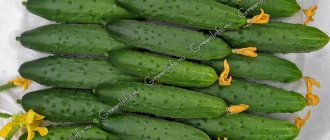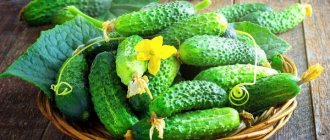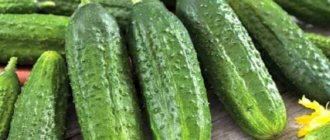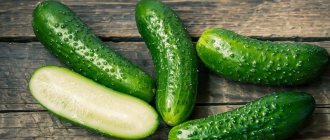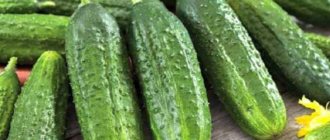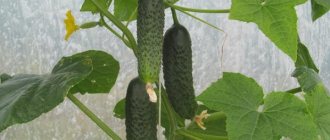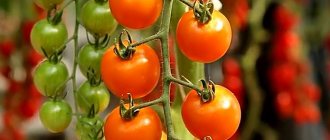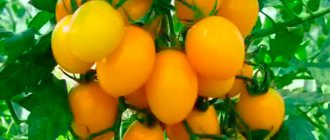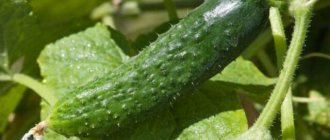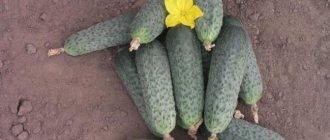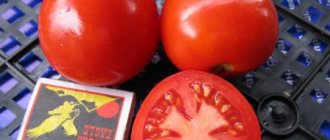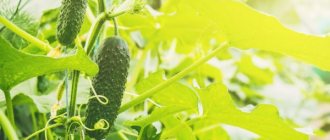The variety is quickly gaining popularity among farmers and ordinary gardeners due to its excellent yield and bunched ovaries. With proper care, one bush is enough to supply the whole family with vitamins and prepare them for the winter.
| Landing location | Ripening time | Mode of application | Fruit length | Group | Fruit smoothness | Pollination method |
| Universal | Early ripening (35-45 days) | Universal | Medium - from 10 to 15 cm | Hybrid | Highly lumpy | Parthenocarpic |
The best cucumber seeds - personal experience
Cucumber is an important vegetable on our table.
Cucumber contains a lot of potassium, and potassium, in turn, strengthens the walls of the heart and all blood vessels, and also removes excess water from the body. This is why, after eating a cucumber, we run to the toilet, and not because the cucumber contains only water. Now, having understood the beneficial properties, let's try to choose the best cucumber seeds. The choice of cucumber seeds should also be based on your preferences and requirements. So, it’s time to talk about how I choose cucumber seeds and which ones turned out to be the best for me.
My requirements when choosing cucumber seeds:
— Firstly, as you already understood from previous articles, I prefer to choose hybrids that give their maximum yield, regardless of weather conditions.
— Secondly, I always choose cucumber seeds, where it is written: the seeds are genetically without bitterness. I want to enjoy the sweet taste of a cucumber at any time and in different situations: a small cucumber, or an overgrown one; the garden bed was watered abundantly, or not very much.
— Thirdly, I choose cucumber seeds intended for pickling, not salad seeds. This is an old tradition: when pickled, salad cucumbers form voids inside, and when you eat this cucumber, it splashes water in different directions. Cucumbers intended for pickling are almost all without bitterness, which is why they are bred so that they do not become bitter when pickled.
— Fourthly, I choose parthenocarpic cucumbers. These cucumbers have female flowers and do not require pollination. Why exactly like this? Because cucumbers bloom still under the film, when it is cold, and it is too early to open the cucumbers, and also subsequently the weather may not always be favorable for the flight of bees. And I want to have a guaranteed harvest of cucumbers.
Another reason why I don’t like salad cucumbers: at the end of July or August, when you no longer run to the cucumber patch every day, if you only hesitate for a few days, the salad gherkins turn into round yellow “balls.”
The problem with water is also very acute in summer: in recent years, in summer the air temperature has risen above +36 0C, sometimes reaching +40+42 0C, and there is no water at all. There can be no talk of any watering. In such a situation, pests quickly develop; for example, last year, after prolonged June rains, heat set in.
Some cucumber bushes were badly damaged by spider mites: should I spray them with chemicals and eat them? The Bush Cucumber was attacked by a spider mite. But some hybrids turned out to be great. Especially the hybrid Well done F1.
The cucumbers are all aligned, and even when they outgrow, they do not turn yellow. And even in September we picked fresh cucumbers.
I do the same with cucumber seeds as with tomato seeds: after buying several bags, I plant only half of the seeds. If I like the cucumbers, I plant the remaining seeds. I simply discard the seeds of cucumbers I don’t like and throw them away. And, naturally, I buy several bags of new products.
Don't plant cucumber seeds too close in the garden. Previously, I planted cucumbers at a distance of 30 cm. Now I have come to the conclusion that the larger the feeding area of a cucumber bush, the higher the yield per plant. Now I try to leave about half a meter between two plants. At the beginning of summer, when the cucumber seedlings are still small, the bed with them seems half empty.
A neighbor, looking over the fence, laments: “Fathers, are the cucumbers missing? And mine came up like a brush!” However, when it comes to the harvest, I harvest it in buckets, and she just asks: “Do you have cucumbers? But I don’t have it yet.” Now, with fewer bushes planted, I get a guaranteed stable and high yield of cucumbers.
Enough for food, salting, and the neighbors!
In September, when it gets colder, feed the cucumber bed and cover it with agrospan and polyethylene film. (This option is suitable for those who do not have greenhouses.
) Until the end of October you will be able to enjoy fresh cucumbers from your garden.
Pests and diseases
Pests can be controlled
Pests
- The whitefly is a small white midge that drinks the sap of plants and leaves behind sooty fungi. A solution of garlic and water (150 g of garlic per 1 liter of water), which is sprayed on cucumbers, helps against whiteflies.
- Aphids like to settle in colonies on leaves and eat them. The consequences of its sabotage are wilting of leaves. A solution of wood ash, soap and water helps against aphids (add 50 g of wood ash and 20 g of soap to 2.5 liters of water).
- Spider mites are small mites that leave webs under leaves where they sit. Spraying a soap solution (1 tablespoon of soap per 1 liter of water) on the back side of the leaves helps against them.
If pests have settled on one bush, you need to try to exterminate them before they spread to the rest.
More effective in the fight against parasites are branded drugs “Tanrek”, “Aktellik”, “Commander”, “Fitoverm”, “Vofatox”, “Kinmiks” and others.
Diseases
Diseases most often appear due to the carelessness of site owners.
- Powdery mildew. White spots appear on the leaves, gradually spreading throughout the plant. Because of it, the leaves dry out and fruiting stops. To combat the disease, the infected parts are cut off and the plants are sprayed with fungicides (10 g of fungicides per 5 liters of water). If the disease spreads strongly, the bush is destroyed.
- Cladosporiosis. Brown cankers appear on the plant and the fruits look rotten. To combat, watering the plant is stopped for 5 days and treated with foundationazole (10 g of foundationazole per 0.5 liter of water). The affected parts of the bush are removed.
- White rot. This is a viscous white consistency that causes the fruits and the bush itself to rot. The affected parts of the plant are removed, the bush is treated with a solution of urea, water, zinc sulfate and copper sulfate (10 g of copper sulfate, urea, zinc sulfate per 2 liters of water).
- Downy mildew. Small yellow spots on leaves. The disease causes the leaves to dry out, and then the entire plant. Stopping watering and feeding for 3-4 days, as well as subsequent treatments with polycarbacin (10 g per 5 liters of water) will help in the fight against this disease.
- Yellowing of leaves. Common yellowing of leaves is often due to a lack of potassium. Spraying the plant with an infusion of ash (200 g per 2.5 liters of water) helps to cope with this.
Hybrids with tufted ovary
Positive reviews indicate the popularity of the bunch cucumber category. These are modern hybrids in which the ovaries are formed by a bunch from the leaf axil. Such plants are more productive.
When choosing seeds of bunch varieties, you need to pay attention to the degree of branching and the ability of the plant to independently limit the growth of lateral shoots. Most cucumber hybrids are plants with a long fruiting period that can withstand low temperatures and dangerous diseases
These are self-fertile or parthenocarpic hybrids. They not only do without pollination, but also independently regulate the intensity of shoot growth.
When reading the description of the variety, pay attention to the stated number of ovaries in each node. Seeds of varieties with ovaries from 8-10 pieces are considered elite
Super bunched cucumbers most often have shortened internodes. With a short stem, their yield differs little from ordinary varieties.
Most hybrids are varieties of bunched cucumbers for open ground with a full set of necessary qualities to grow effectively and produce a harvest. The seeds of unusual cucumbers are a real achievement of breeders. They embody the best qualities of plants; they are versatile, hardy, and high-yielding.
Summer resident's dream F1
The name speaks for itself - this is, of course, our most popular parthenocarpic hybrid in recent years. It is distinguished by its ultra-earliness (the period from germination to the beginning of fruiting is 38-42 days) and disease resistance.
The plant is powerful, with short internodes, which makes it ideal for growing in low garden greenhouses and on balconies, where there is a limit on the length of the vine.
Thanks to this same feature, the total number of nodes on the plant increases. Considering that at least 6-10 cucumbers ripen in each node, the total yield reaches 8 kg per plant.
The hybrid Summer Resident's Dream is unpretentious and tolerates lack of light, which allows it to be used in shaded areas.
You can learn more about the features of each hybrid from the video review:
Super bunch cucumbers - why they are good and which seeds to choose
A real summer resident's dream is cucumbers that do not require pollination, are not afraid of bad weather and diseases, and bring a generous harvest of crunchy, aromatic fruits. All this is possible if you sow high-quality cucumber seeds with superbunched ovaries.
“Agrofirm AELITA” has found a solution to these problems! The pride of the company is early parthenocarpic cucumber hybrids with a bunched ovary arrangement. These hybrids do not require pollination by bees, and the plants are completely free of barren flowers. And the main distinguishing quality of these cucumbers is their resistance to diseases and adverse weather conditions.
This list contains only some of the modern highly productive hybrids bred by our company’s specialists. Take note, because these seeds guarantee you an excellent harvest of cucumbers.
Little Humpbacked Horse F1
Many summer residents have already become acquainted with the early ripening parthenocarpic hybrid of the gherkin type, the Little Humpbacked Horse. At the nodes of each plant, at least 8 ovaries are formed, which, if formed correctly, gradually ripen, forming a garland of delicious cucumbers.
This hybrid has a long fruiting period and will delight you with a harvest from June to September. It has performed well in different climatic regions and is resistant to sudden changes in weather conditions.
The Little Humpbacked Horse also fell in love with the townspeople, who, using it, get a rich harvest of cucumbers on the balcony.
Five stars F1
This is a super-bundled, ultra-early parthenocarpic hybrid of the latest generation. At the same time, 5-10 ovaries are formed in each internode.
Zelentsy are small, about 9-10 cm long, finely tuberculate with an absolute absence of bitterness. They are ideal for fresh consumption and winter storage. When salted and marinated, they retain their shape, density and elasticity.
Five Star cucumbers boast the ability to withstand cold spells without damaging the yield and intensity of fruiting. The hybrid is resistant to root rot, cladosporiosis, cucumber mosaic virus and powdery mildew.
F1 Buddies
At the same time, the size of the greens is compact, they do not outgrow, and have an excellent presentation. Their pulp is without bitterness and voids.
The Friends-Friends cucumber has gained popularity not only among summer residents, but also among large producers, since its characteristics significantly surpass the main well-known Dutch hybrids.
Grandma's Secret F1
The hybrid is attractive due to its early ripening: the period from the emergence of seedlings to the first cucumbers is only 40 days. At the same time, already at the very beginning of summer, a lot of greens form on the plant - you will see a real inflorescence of gherkins!
The fruits of this cucumber never taste bitter and have excellent taste. Grandmother's Secret tolerates cold nights and sudden temperature changes well. Thanks to the quick and abundant yield of the crop, this cucumber can be safely sown in the northern regions, where it has already found favor with gardeners.
The name speaks for itself - this is, of course, our most popular parthenocarpic hybrid in recent years. It is distinguished by its ultra-earliness (the period from germination to the beginning of fruiting is 38-42 days) and disease resistance.
The plant is powerful, with short internodes, which makes it ideal for growing in low garden greenhouses and on balconies, where there is a limit on the length of the vine.
The hybrid Summer Resident's Dream is unpretentious and tolerates lack of light, which allows it to be used in shaded areas.
Of course, just buying quality seeds is not enough. To remove the maximum number of fruits from a plant, it is also necessary to form them correctly.
We propose to adopt a scheme for the formation of parthenocarpic hybrids in a greenhouse (6-12 ovaries per node).
- 0 ZONE. In the axils of the first 3-4 leaves, blinding is carried out (the buds of shoots and ovaries are carefully plucked out without touching the leaves themselves).
- 1 ZONE. Form into one stem. Along the entire length of the main stem, all the buds of the side shoots are plucked out, and the ovaries are left.
- ZONE 2. The main stem is wrapped several times around the trellis wire and pinched as soon as it reaches the neighboring plant. All side shoots in this section of the stem are removed.
Without exaggeration, the cucumber can be called the king of garden beds.
Add to cart
No discounts
Pests and diseases
Pests can be controlled
Pests
- The whitefly is a small white midge that drinks the sap of plants and leaves behind sooty fungi. A solution of garlic and water (150 g of garlic per 1 liter of water), which is sprayed on cucumbers, helps against whiteflies.
- Aphids like to settle in colonies on leaves and eat them. The consequences of its sabotage are wilting of leaves. A solution of wood ash, soap and water helps against aphids (add 50 g of wood ash and 20 g of soap to 2.5 liters of water).
- Spider mites are small mites that leave webs under leaves where they sit. Spraying a soap solution (1 tablespoon of soap per 1 liter of water) on the back side of the leaves helps against them.
If pests have settled on one bush, you need to try to exterminate them before they spread to the rest.
More effective in the fight against parasites are branded drugs “Tanrek”, “Aktellik”, “Commander”, “Fitoverm”, “Vofatox”, “Kinmiks” and others.
Diseases
Diseases most often appear due to the carelessness of site owners.
- Powdery mildew. White spots appear on the leaves, gradually spreading throughout the plant. Because of it, the leaves dry out and fruiting stops. To combat the disease, the infected parts are cut off and the plants are sprayed with fungicides (10 g of fungicides per 5 liters of water). If the disease spreads strongly, the bush is destroyed.
- Cladosporiosis. Brown cankers appear on the plant and the fruits look rotten. To combat, watering the plant is stopped for 5 days and treated with foundationazole (10 g of foundationazole per 0.5 liter of water). The affected parts of the bush are removed.
- White rot. This is a viscous white consistency that causes the fruits and the bush itself to rot. The affected parts of the plant are removed, the bush is treated with a solution of urea, water, zinc sulfate and copper sulfate (10 g of copper sulfate, urea, zinc sulfate per 2 liters of water).
- Downy mildew. Small yellow spots on leaves. The disease causes the leaves to dry out, and then the entire plant. Stopping watering and feeding for 3-4 days, as well as subsequent treatments with polycarbacin (10 g per 5 liters of water) will help in the fight against this disease.
- Yellowing of leaves. Common yellowing of leaves is often due to a lack of potassium. Spraying the plant with an infusion of ash (200 g per 2.5 liters of water) helps to cope with this.
Cucumber Little Humpbacked Pipit F1. AelitaThe Most Fruitful Cucumber “Humpbacked Horse” WE HAVE NEVER SEEN THIS. CUCUMBER SHOSHA F1Ultra-early Cucumber “5 stars”
We must ensure that the disease does not spread from the diseased plant to the healthy one.
If the disease has gone too far, the only option left is to get rid of the planting.
F1 Buddies
Bunch hybrid with ultra-high yield potential. Thanks to many years of selection work, plants can form a highly developed root system and receive the maximum amount of nutrients during the growing season. Therefore, almost all the fruits ripen in a bunch, which ensures a huge harvest (up to 20 kg per 1 sq.m.!).
At the same time, the size of the greens is compact, they do not outgrow, and have an excellent presentation. Their pulp is without bitterness and voids.
The Friends-Friends cucumber has gained popularity not only among summer residents, but also among large producers, since its characteristics significantly surpass the main well-known Dutch hybrids.
Grandma's Secret F1
Grandma's secret cucumber is our new product. This parthenocarpic hybrid for open and protected ground was included in the State Register only in 2015. It has not yet become widespread among amateur gardeners, but everything is ahead of it!
The hybrid is attractive due to its early ripening: the period from the emergence of seedlings to the first cucumbers is only 40 days. At the same time, already at the very beginning of summer, a lot of greens form on the plant - you will see a real inflorescence of gherkins!
The fruits of this cucumber never taste bitter and have excellent taste. Grandmother's Secret tolerates cold nights and sudden temperature changes well. Thanks to the quick and abundant yield of the crop, this cucumber can be safely sown in the northern regions, where it has already found favor with gardeners.
Video “Growing cucumbers in open ground”
How to choose the right site for planting cucumbers, how to form beds and apply fertilizers, how to protect plants from diseases and pests and get a rich harvest, this and much more can be learned by watching this video.
Cucumbers are rightfully considered one of the most popular garden crops - an unpretentious and very juicy vegetable, without which not a single summer salad can do. Growing cucumbers also has many nuances that ensure stable success.
An important task and the key to future harvests is the correct choice of seeds suitable for cultivation in open ground or greenhouse conditions. Our article will tell you how to choose the most suitable varieties from the entire diverse range.
Shops and websites of the relevant profile offer many varieties of the most unusual varieties. There may be many options, but for successful cultivation you must first familiarize yourself with the most suitable ones. Conventionally, all varieties can be divided into salad and pickling cucumbers, as well as universal hybrids.
Salad varieties of cucumbers have an elongated shape and thin skin. They are not suitable for storage or pickling, but due to their ideal taste they are used in salads and appetizers. The main advantage, in addition to taste, is the large weight of the fruit, as well as high yield.
You can learn how to grow cucumbers in open ground from this
Salad cucumbers for open ground:
- Phoenix Plus.
- "Beaver F1".
- "Picas F1".
- "White Angel F1".
- "Rafael F1".
- Mill F1".
- "F1 Movir - 1".
- "Parade".
- "Abundant".
- "Unbearable."
- "Adam F1".
- "Elegant".
- "Stash F1".
- "Saltan F1".
- "Nugget".
- "Humpbacked Horse F1".
- "Marinade F1".
Cucumber varieties marked “F1” belong to the first generation hybrids and are not intended for further propagation. You cannot collect seeds from them for the next year, because at best you will simply get an ordinary variety that does not have all the qualities of the “parent” plant, and maybe a barren flower will grow.
The video shows the best varieties of early cucumbers for open ground:
Description
The cucumber hybrid “Connie F1” is parthenocarpic , that is, it does not require the participation of pollinating insects to form ovaries and fill fruits. (Many people mistakenly call such hybrid forms “self-pollinating.”)
All original varieties of cucumbers are dioecious, that is, they have flowers of different sexes and require pollination by insects that transfer pollen from male flowers (barren flowers) to female ones
Unlike bee-pollinated varieties and hybrids of cucumbers, parthenocarpic ovaries grow into greens without fertilization, which significantly reduces the dependence of their yield on weather conditions and the presence of insects. The seeds in unfertilized greens do not have embryos and therefore do not ripen. This property has a positive effect:
- on taste: the seeds are small and tender, without a rough shell;
- on marketability of appearance: the fruits have almost the same size and color, do not overgrow, do not become deformed, and do not turn yellow.
Even if parthenocarpics are pollinated and full-fledged seeds ripen in them, it makes no sense to use such seed material for planting the next season. All heterotic hybrids labeled “F1” combine improved parental qualities and exhibit them only in the first generation.
Note that the development of hybrids with stable parthenocarpic properties is an achievement of selection, not GMO.
Many plants exhibit a natural tendency towards parthenocarpic development of fruits (in addition to cucumbers, these are tomatoes, apples, pears, grapes, tangerines, etc.). And in parthenocarpic hybrids, this property was consolidated at the level of a genetic trait.
Many note the high early yield of the cucumber hybrid “Connie F1”
Of course, vegetable crops that do not require pollination are intended primarily for growing in protected soil conditions - under film covers, in all types of greenhouses, where insect access is limited. In such situations, parthenocarpics are more convenient and profitable, as they provide stable high yields.
The marketable yield of “Connie F” cucumbers is up to 16 kg/m2, and the early yield is 8.7-9.2 kg/m2, due to which the hybrid is considered one of the best in the first (spring-summer) rotation.
Although the “Connie F1” hybrid is declared as early ripening, in terms of ripening time it would be more correct to call it medium , since fruiting begins on the 47-50th day from the moment of the appearance of full shoots.
Indeterminate cucumbers in greenhouse conditions are grown vertically, tying and wrapping vines around a stretched trellis or net, forming bushes according to various patterns
The plant is indeterminate , that is, unlimited in growth, powerful and vigorous with medium climbing and foliage. The leaves are small, wrinkled, with regular crenate edges.
The type of flowering is female , which ensures a large number of ovaries, which are often laid in bunches (from 3 to 9 pieces per node), and the absence of barren flowers.
The greens of the hybrid “Connie F1” are distinguished by their small (gherkin) size and small tubercles often located on the surface
Zelentsy are very short , gherkin-type - 7-9 cm, proportional, cylindrical-oval in shape, round in cross section. The average weight of greens is 60-82 g, the taste is excellent, without bitterness . The surface is covered with small and frequent tubercles, the pubescence is white, non-spiny. The skin is thin, rich green in color, the flesh is dense, juicy, and does not form voids during heat treatment. Greens are used fresh (as salad greens), and also salted and pickled.
Packages with seeds of the hybrid variety of cucumbers “Connie F1” from various manufacturers
The hybrid is valued for its resistance to powdery mildew and root rot, endurance in unfavorable conditions, for example, with temperature changes, and unpretentiousness.
In agricultural cultivation technology, this hybrid is not particularly difficult: it is important to choose the right time for sowing seeds or planting seedlings, watering and fertilizing plants in a timely manner, weeding and loosening the soil. To obtain maximum yield and longevity of the harvest, it is recommended to shape the bushes. How to form parthenocarpic hybrid cucumber plants in a greenhouse, see the video at the end of the article.
Scheme for forming bunched cucumbers
Of course, just buying quality seeds is not enough. To remove the maximum number of fruits from a plant, it is also necessary to form them correctly.
We propose to adopt a scheme for the formation of parthenocarpic hybrids in a greenhouse (6-12 ovaries per node).
- 0 ZONE. In the axils of the first 3-4 leaves, blinding is carried out (the buds of shoots and ovaries are carefully plucked out without touching the leaves themselves).
- 1 ZONE. Form into one stem. Along the entire length of the main stem, all the buds of the side shoots are plucked out, and the ovaries are left.
- ZONE 2. The main stem is wrapped several times around the trellis wire and pinched as soon as it reaches the neighboring plant. All side shoots in this section of the stem are removed.
Using the developments of AELITA Agrofirm, you are guaranteed to receive an abundance of crispy, juicy, appetizing cucumbers that will delight you not only in the summer, but also in pickles all year round.
You can always find detailed information about our hybrid varieties on our website www.ailita.ru.
We are also waiting for you in our groups on social networks, where you can learn a lot of new things both about the company itself and about our breeding achievements.
Seeds Cucumber “Humpbacked Horse” F1, early ripening parthenocarpic, 7 pcs.
Add to cart
No discounts
- Are common
- Trademark Agrofirm AELITA
- Article 2760530
- Certificate Not subject to certification
- Country of origin: Russia
- Composition See on packaging
- Packaging
- 1000 pcs in box
- Packaging 10 pcs.
- Individual packaging No packaging
- Package size 12 cm × 7.5 cm × 0.1 cm
- Dimensions and weight
- Gross weight 2 g
- Peculiarities
- Species Self-pollinating
- Ripening time: Early
- Packaging Colored
- Variety or hybrid Hybrid F1
“Humpbacked Horse” is an early-ripening hybrid variety with record yields. Designed for growing under film covers. The plant produces short, tuberous, white-thorned fruits with a rich taste without bitterness. The hybrid is resistant to crop diseases.
Period from germination to harvest: 43–45 days.
Productivity: 19–21 kg/m².
Fruit weight: 80–100 g.
How to plant. Seeds are sown in the ground or for seedlings. The age of seedlings at planting is 20–30 days. The planting density in greenhouses is 2–3 plants per m². Plants are tied to a trellis and formed into one stem. Side shoots are pinched above the second or third leaf.
Sima-land has the right to independently and without notifying users select questions for publication. We do not post questions that:
- do not relate to the subject of the store’s operation or making purchases in it;
- contain profanity, offensive statements;
- contain links to other websites.
We do not publish questions that contain:
- links to other websites, as well as references to specific sellers and importers of goods;
- statements discrediting the honor, dignity and business reputation of third parties (including stores, manufacturers and importers of goods);
- materials (including in the form of text, video, graphic images, code) that violate the rights of third parties, including rights to results of intellectual activity and means of individualization.
Sima-land reserves the right to delete a published question at any time, as well as independently determine the period during which questions are considered relevant and for which they are published within the Sima-land website.
We do not undertake any obligation to inform users of the reasons for rejecting questions or deleting previously posted questions.
If a user asks a question, he agrees to receive notifications from the Sima-land website about new answers to his questions.
Sima-land has the right to independently and without notifying users select reviews for publication. We do not post reviews that:
- do not relate to the subject of the store’s operation or making purchases in it;
- do not relate to actual experience of using this product;
- do not contain useful information for other users;
- contain profanity, offensive statements;
- contain links to other websites.
We do not publish selections and reviews of products that contain:
- links to other websites in the text of the selection and review, as well as mentions of specific sellers and importers of goods;
- statements discrediting the honor, dignity and business reputation of third parties (including stores, manufacturers and importers of goods);
- materials (including in the form of text, video, graphic images, code) that violate the rights of third parties, including rights to results of intellectual activity and means of individualization.
Sima-land reserves the right to delete a published review, selection and review of products at any time, as well as independently determine the period during which reviews are considered relevant and for which they are published within the Sima-land website.
We do not undertake any obligation to inform users of the reasons for rejecting publication or deleting previously published reviews, ratings, selections and product reviews.
If a user responds to a review or question, he agrees to receive notifications from the Sima-land website about new replies to his comments.
Description and characteristics of the variety
Little Humpbacked Horse F1 is a hybrid variety. Its originator is the company Agro Aelita. It has medium bushes, the main vine of which reaches no more than 1.5 meters. Flowering, and then the formation of ovaries, is bouquet, 7-8 pieces in a bunch. The flowers are self-pollinating (parthenocarpic) and do not require insects. Therefore, the hybrid can be grown both in greenhouses and in the open air. Harvesting begins 43-45 days after seed germination.
The fruits are about 12 cm long and weigh 80-100 g. The skin has an average number of large tubercles and white spines. The pulp is juicy, tasty and tender.
Varieties and hybrids
Tournament
- Chic
- branching includes early ripening sprinter hybrids that give away most of the harvest in the 1st month of fruiting: F1 Alphabet, F1 Cupid, F1 Regina-plus, F1 Bouquet, F1 Balalaika, etc. There are practically no side shoots - i.e. They are very short (up to 10-15 cm) “bouquet branches” - with close internodes, often without leaves, which stop growing on their own. Such bouquet branches with filling greens look like bunches of fruits.
- Salad cucumbers have medium-sized smooth or lumpy fruits. Greens have no bitterness, they have a crispy, sweetish flesh and are eaten fresh (F1 Zozulya, F1 Bazaar, F1 Bukhara, F1 Tamerlane, F1 Kochubey, F1 Marta, F1 Makar, etc.).
- F1 Compass
The seeds of greenhouse cucumbers that are best suited for fresh consumption include the following varieties:
Pros and cons of the Little Humpbacked Horse raspberry
The Little Humpbacked Horse is great both for growing raspberries “for yourself” and for production scale. The variety has a number of advantages:
- large and very tasty fruits that ripen faster than other representatives of this crop;
- Every year the level of raspberry productivity increases;
- the berries can easily withstand long-term transportation;
- raspberries reproduce easily and quickly, so you don’t have to spend money on a large number of seedlings;
- The Little Humpbacked Horse begins to bear fruit already in the first year after planting;
- The variety is relatively resistant to light frosts;
- the variety is quite unpretentious in terms of care;
As you can see, raspberries have a sufficient number of positive aspects. But, despite their large number, the bush also has a number of negative aspects:
- The humpbacked horse sends out many shoots, which in a short period of time can clog the entire area. It is necessary to constantly monitor the bush and the degree of its growth.
- You need to monitor the pH level of the soil: if it is acidic, then the raspberries will not produce a large harvest.
Attention! Comparing the positive and negative aspects of raspberry varieties, you can see that the advantages prevail by a large margin. It is for this reason that gardeners look forward to the appearance of the Little Humpbacked Horse with such impatience.
The Little Humpbacked Horse is a variety of the Cucumber plant.
Variety characteristics:
Properties of the Little Humpbacked Horse variety:
Recommended region on the map:
Information on the admission of Cucumber Little Humpbacked Horse from the Register of the State Variety Commission of the Russian Federation
Application for admission No. 48099, registered 2007-08-30. The Cucumber variety Little Humpbacked Horse was included in the register of those approved in 2008. Approved for use in regions: All regions.
The originator of the Cucumber variety Little Humpbacked Horse is:
Information about the patent for the variety Cucumber Little Humpbacked Horse
Patent holder of the Little Humpbacked Horse variety:
- LLC `AGROFIRMA AELITA` (129343, MOSCOW, NANSEN TRADE, 1)
Application for protection of the variety Konek-Gorbunok No. 48100, registered 2007-08-30.
Patent No. 4577, registered 2009-02-27. Estimated patent expiration date 2039-12-31.
Authors of the variety Cucumber Little Humpbacked Horse
- Nastenko Natalya Viktorovna
- Kachainik Vladimir Georgievich
- Kandoba Alexey Viktorovich
Other plant varieties Cucumber
Search for variety by name
Variety selection
Cucumber “Humpbacked Horse” F1 in Moscow
You can always place an order and pay for it online on the official website of Leroy Merlin in Russia. For residents of the Moscow region, we not only have low prices for products such as “Cucumber “The Little Humpbacked Horse” F1”, but also fast delivery to cities such as Moscow, Balashikha, Podolsk, Khimki, Korolev, Mytishchi, Lyubertsy, Krasnogorsk, Elektrostal, Kolomna, Odintsovo, Domodedovo, Serpukhov, Shchelkovo, Orekhovo-Zuevo, Ramenskoye, Dolgoprudny, Pushkino, Reutov, Sergiev Posad, Voskresensk, Lobnya, Klin, Ivanteevka, Dubna, Yegoryevsk, Chekhov, Dmitrov, Vidnoye, Stupino, Pavlovsky Posad, Naro-Fominsk, Fryazino, Lytkarino, Dzerzhinsky, Solnechnogorsk, Istra and Zhukovsky.
Growing and care
Upon disembarkation
When planting seedlings per 1 sq. m place 3-4 plants. A little wood ash and superphosphate are placed in the holes. If the seeds are sown directly into the soil, then it is prepared in the fall - they dig it up and apply organic fertilizers.
After landing
The beds are watered every 3-4 days or daily in hot weather. They use warm water, which is previously left in barrels in the sun. Do not allow the soil to dry out or sit in water for a long time, otherwise the roots will suffer.
Supports are built for the lashes and the bushes are tied up
Regularly weed the weeds and carefully loosen the soil so as not to damage the roots.
Feed 2-3 times per season, using organic solutions of manure and bird droppings, as well as mineral fertilizers.
Plants need nitrogen, phosphorus and potassium. A balanced amount of these substances is contained in superphosphate, potassium nitrate, ammophosphate, and urea.
Care
If you follow all the rules of care, problems with diseases and pests will not arise.
Care upon landing
Seeds are planted in the first ten days of April. Cucumber grains are planted after pre-treating them with a solution of water and useful minerals. It is recommended to use small pots with good soil. After fertilizing the soil, the seeds are planted to a depth of about 3 cm. The soil is watered every day, without overdoing it, so that the soil does not become sour.
Care after landing
Proper care of the Humpbacked Horse variety involves following basic rules. Remains of other vegetation, dirt, and weeds are removed from the site. When the bush has grown enough, it is tied to a trellis to provide support. During the development period, the bush is fed. Without proper care, the plant may become sick or die.
How to get a harvest of cucumbers in cold summer
First, check the long-range weather forecast for your area. What do the services promise: drought, rain, heat, cold?
To increase cold resistance, cucumber seeds are hardened and treated with stimulants. A week before planting in the ground, seedlings are kept at temperatures up to 16 ... 18 ° C. In good weather, you can take it out onto the balcony, but just do not place it in direct sunlight.
If the forecast predicts a cold June, planting in open ground begins as soon as the threat of frost has passed and the soil has warmed up. Covering plants with lutrasil or film will help protect plants from cold weather. Don't rush to take it off! If you remove the cover in cold weather, the growth of plants and fruits will stop.
Due to abrupt changes in the growth rate, crooked or “constricted” fruits may appear. Only when the weather is very hot and the covers can cause leaf burns are they opened slightly during the daytime. If you remove the covers completely, the plants are early damaged by powdery mildew. For ventilation, it is enough to raise the shelter on one side.
Cucumbers are a moisture-loving crop, but in cool and rainy weather the frequency and volume of watering should be reduced. In greenhouses and greenhouses, plants are watered in the first half of the day only with warm water (not lower than 18 ... 20 ° C). During prolonged cloudy weather, it is recommended to feed the plants leaf by leaf with complex water-soluble fertilizers with microelements at a concentration of 0.1% (1 g of fertilizer per 1 liter of water).
Often, due to sudden changes in temperature, plants stop growing vegetative mass and instead form a large number of female flowers with ovaries at the top of the shoot. If the topping is not strong, you need to remove the ovaries or greens at the bottom of the stem and several large ones at the top; if it is strong, all the ovaries and flowers at the top are removed. Feed the plants leaf by leaf with nitrogen fertilizers or growth stimulants (Epin-extra, Zircon).
Landing
To grow a crop in a greenhouse, seeds are sown for seedlings in early April, for open ground - at the end of the month. You can sow directly on the beds at the end of May-June, but only in the southern regions with long summers.
Cucumbers need loose, nutritious soil with good drainage and acidity pH 6-7. In a permanent place, it should be heated to +14 or higher; for seedlings to germinate, +20-25 degrees is required.
The seed of hybrids does not need to be treated with anything. For seedlings, prepare small peat pots with a diameter of 12 cm and a nutrient substrate. Place 1-2 grains in each container, moisten them, cover them with film and germinate in a warm place. The emerging sprouts are moved to a sunny place and the temperature is provided at +18-20 degrees.
Little Humpbacked Horse F1
Many summer residents have already become acquainted with the early ripening parthenocarpic hybrid of the gherkin type, the Little Humpbacked Horse. At the nodes of each plant, at least 8 ovaries are formed, which, if formed correctly, gradually ripen, forming a garland of delicious cucumbers.
The greens of the Little Humpbacked Horse are short, with thin skin, without bitterness. They are recommended for fresh consumption and canning.
This hybrid has a long fruiting period and will delight you with a harvest from June to September. It has performed well in different climatic regions and is resistant to sudden changes in weather conditions.
The Little Humpbacked Horse also fell in love with the townspeople, who, using it, get a rich harvest of cucumbers on the balcony.
Five stars F1
This is a super-bundled, ultra-early parthenocarpic hybrid of the latest generation. At the same time, 5-10 ovaries are formed in each internode.
Zelentsy are small, about 9-10 cm long, finely tuberculate with an absolute absence of bitterness. They are ideal for fresh consumption and winter storage. When salted and marinated, they retain their shape, density and elasticity.
Five Star cucumbers boast the ability to withstand cold spells without damaging the yield and intensity of fruiting. The hybrid is resistant to root rot, cladosporiosis, cucumber mosaic virus and powdery mildew.
